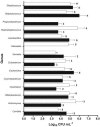Effect of pH and antibiotics on microbial overgrowth in the stomachs and duodena of patients undergoing percutaneous endoscopic gastrostomy feeding
- PMID: 16000416
- PMCID: PMC1169167
- DOI: 10.1128/JCM.43.7.3059-3065.2005
Effect of pH and antibiotics on microbial overgrowth in the stomachs and duodena of patients undergoing percutaneous endoscopic gastrostomy feeding
Abstract
Enteral nutrition via a percutaneous endoscopic gastrostomy (PEG) tube is often part of management in patients with dysphagia due to neurological or oropharyngeal disease. Gastrostomy placement can affect normal innate defense mechanisms in the upper gut, resulting in bacterial overgrowth. In this study microbiological investigations were done with gastric and duodenal aspirates from 20 patients undergoing PEG tube placement and PEG tubes from 10 patients undergoing tube replacement. Aspirate and PEG tube microbiotas were assessed by using viable counts and selective solid media followed by aerobic and anaerobic incubation to assess cell viabilities. The antibiotic susceptibility profiles of the isolates were determined by the disk diffusion method, and gas chromatography was used to study the bacterial metabolic products in the aspirates. The aspirates and PEG tubes contained mainly streptococci, staphylococci, lactobacilli, yeasts, and enterobacteria. Enterococci were detected only in PEG tube biofilms and not in aspirates. Gastric pH affected the composition of the aspirate microbiotas but not the total microbial counts. Staphylococci, Escherichia coli, and Candida spp. were isolated only from antibiotic-treated patients, despite the sensitivities of the bacteria to the agents used. Antibiotic treatment had no effect on the incidence of infection or the length of hospital stay in these patients.
Figures



Similar articles
-
Effect of pH on an in vitro model of gastric microbiota in enteral nutrition patients.Appl Environ Microbiol. 2005 Aug;71(8):4777-83. doi: 10.1128/AEM.71.8.4777-4783.2005. Appl Environ Microbiol. 2005. PMID: 16085875 Free PMC article.
-
Effects of percutaneous endoscopic gastrostomy tube placement on gastric antral motility and gastric emptying.J Gastroenterol. 2003;38(10):930-6. doi: 10.1007/s00535-003-1174-z. J Gastroenterol. 2003. PMID: 14614599
-
Enteral nutrition during the treatment of head and neck carcinoma: is a percutaneous endoscopic gastrostomy tube preferable to a nasogastric tube?Cancer. 2001 May 1;91(9):1785-90. Cancer. 2001. PMID: 11335904
-
The technique of percutaneous endoscopic gastrostomy. A safe and cost-effective alternative to operative gastrostomy.J Crit Illn. 1991 Jun;6(6):611-9. J Crit Illn. 1991. PMID: 10147918 Review.
-
Complications related to percutaneous endoscopic gastrostomy (PEG) tubes. A comprehensive clinical review.J Gastrointestin Liver Dis. 2007 Dec;16(4):407-18. J Gastrointestin Liver Dis. 2007. PMID: 18193123 Review.
Cited by
-
Microbial biofilms and gastrointestinal diseases.Pathog Dis. 2013 Feb;67(1):25-38. doi: 10.1111/2049-632X.12020. Epub 2013 Jan 29. Pathog Dis. 2013. PMID: 23620117 Free PMC article. Review.
-
Obesity, Gut Microbiota, and Metabolome: From Pathophysiology to Nutritional Interventions.Nutrients. 2023 May 9;15(10):2236. doi: 10.3390/nu15102236. Nutrients. 2023. PMID: 37242119 Free PMC article. Review.
-
Polymicrobial interactions: impact on pathogenesis and human disease.Clin Microbiol Rev. 2012 Jan;25(1):193-213. doi: 10.1128/CMR.00013-11. Clin Microbiol Rev. 2012. PMID: 22232376 Free PMC article. Review.
-
The noncolonic microbiome: does it really matter?Curr Gastroenterol Rep. 2010 Aug;12(4):259-62. doi: 10.1007/s11894-010-0111-6. Curr Gastroenterol Rep. 2010. PMID: 20532707 Review.
-
Suppression of gastric acid production by proton pump inhibitor treatment facilitates colonization of the large intestine by vancomycin-resistant Enterococcus spp. and Klebsiella pneumoniae in clindamycin-treated mice.Antimicrob Agents Chemother. 2006 Nov;50(11):3905-7. doi: 10.1128/AAC.00522-06. Epub 2006 Aug 28. Antimicrob Agents Chemother. 2006. PMID: 16940078 Free PMC article.
References
-
- Bauer, T. T., A. Torres, R. Ferrer, C. M. Heyer, G. Schultze-Werninghaus, and K. Rasche. 2002. Biofilm formation in endotracheal tubes. Association between pneumonia and the persistence of pathogens. Monaldi Arch. Chest. Dis. 57:84-87. - PubMed
-
- Berg, R. D. 1996. The indigenous gastrointestinal microflora. Trends Microbiol. 4:430-435. - PubMed
-
- Cabre, E., and M. A. Gassull. 1993. Complications of enteral feeding. Nutrition 9:1-9. - PubMed
Publication types
MeSH terms
Substances
LinkOut - more resources
Full Text Sources
Medical
Miscellaneous

